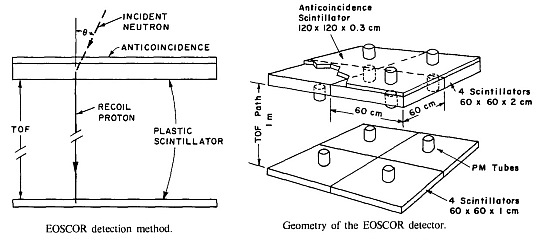Purpose of the flight and payload description
EOSCOR was the acronym of Extended Observation of Solar Cosmic Radiation, a balloon-borne detector for measuring solar flare neutrons in the energy range 20 to 150 MeV. The instrument was designed at the Case Western Reserve University during late 1970's decade to take advantage of the several projects which were on the making at the time for long-duration balloon flights.
In the scheme at left we can see an scheme of the detector (click to enlarge). EOSCOR was composed by two scintillators separated by a 1 meter time-of-flight (TOF) path. Neutrons incident on the detector produced protons via scatterings and interactions in the upper scintillator. TOF was then used to discriminate the slower moving proton recoils from the copious relativistic Compton electrons generated by the atmospheric and cosmic gamma-radiation. Complete protection against data contamination by charged particle induced events was provided by veto counters placed above the upper scintillator and below the lower scintillator. The energy loss in the upper scintillator and the proton's velocity (as determined from the TOF measurement) were combined to give the energy of the proton recoil. Solar neutron events were then characterized by an increase in the neutron counting rate over the atmospheric background, correlated in time with a flare. Since the gondola orientation and the position of the sun were known, the incident neutron energy could be determined from the measured proton energy by simple scattering kinematics.
Details of the balloon flight
Balloon launched on: 4/15/1977 at 6:08 local
Launch site: Broken Hill, New South Wales, Australia
Balloon launched by: Australian Balloon Launch Station (ABLS)
Balloon manufacturer/size/composition: Zero Pressure Balloon
Flight identification number: FLT Nº 671
End of flight (L for landing time, W for last contact, otherwise termination time): 4/15/1977
Balloon flight duration (F: time at float only, otherwise total flight time in d:days / h:hours or m:minutes - ): 1 h
Landing site: Balloon burst at 40.000 ft.
EOSCOR I was launched at 6:08 local time on April 15, 1977 from Broken Hill Airport in New South Wales, Australia. After a nominal launch the balloon started to ascend at 1000 ft/min, but unfortunately just when crossing the stratopause at 40.000 ft the balloon burst. Although the gondola did not reach float altitude, the detector had been turned on before launch, and therefore data were acquired from ground level to 40kft, which was the latitude of minimum temperature and also was approaching the level at which the atmospheric neutrons have their maximum flux.
External references
- EOSCOR: A light weight, microprocessor controlled solar neutron detector Nuclear Instruments and Methods Volume 165, Issue 1, 15 September 1979, Pages 47-54
10187If you consider this website interesting or useful, you can help me to keep it up and running with a small donation to cover the operational costs. Just the equivalent of the price of a cup of coffee helps a lot.


